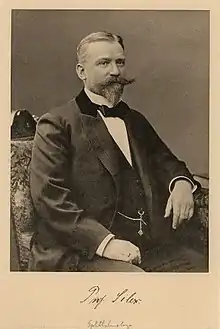
Paul Silex (1858-1929)
Paul Silex (20 March 1858, Gorgast – 20 January 1929, Berlin) was a German ophthalmologist. He is known for contributions made involving war-related blindness.
He studied medicine at the Universities of Halle, Berlin and Breslau, obtaining his doctorate in 1883. Afterwards he served as an assistant to ophthalmologist Ludwig Laqueur (1839-1909) in Strasbourg, followed by several years (1884-1897) as an assistant to Karl Ernst Theodor Schweigger (1830-1905) in Berlin.
He received his habilitation in 1890, becoming an associate professor in 1897.[1] In Berlin he opened a private clinic at St. Maria Victoria-Krankenhaus.[2]
Associated eponym
- "Silex's sign": A pathognomonic sign of congenital syphilis, indications being radial furrows about the mouth.[3]
Selected writings
- Compendium der Augenheilkunde, 1899 - Compendium of ophthalmology; (published over several editions).
- Über das Sehvermögen der Eisenbahnbeamten, 1894 - On the vision of railway officials.[4]
- Neue Wege in der Kriegsblindenfürsorge, 1916 - New approaches to war-blind welfare.[5]
References
- ↑ Geschichte der Augenheilkunde, Volume 8 by Julius Hirschberg (short biography, lengthy list of publications
- ↑ ZVAB.com Augenheilkunde und Ophthalmoskopie by Schmidt-Rimpler, Hermann
- ↑ The journal of the Kansas Medical Society, Volume 18 by Kansas Medical Society
- ↑ Pagel: Biographisches Lexikon hervorragender Ärzte des neunzehnten Jahrhunderts. Berlin, Wien 1901, Sp. 1595.
- ↑ IDREF.fr (bibliography)
This article is issued from Wikipedia. The text is licensed under Creative Commons - Attribution - Sharealike. Additional terms may apply for the media files.